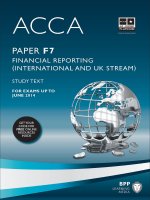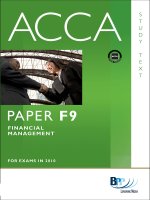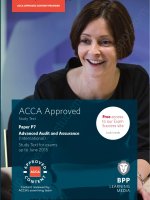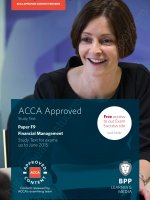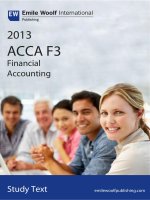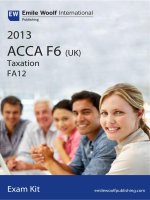ACCA f3 EW study text 2013 FInancial accounting
Bạn đang xem bản rút gọn của tài liệu. Xem và tải ngay bản đầy đủ của tài liệu tại đây (3.01 MB, 518 trang )
Publishing
2013
ACCA F3
Financial
Accounting
Study Text
emilewoolfpublishing.com
ACCA
Paper
F3
Financial
Accounting
Welcome to Emile Woolf‘s study text for
Paper F3 Financial Accounting which is:
Written by tutors
Comprehensive but concise
In simple English
Used around the world by Emile Woolf
Colleges including China, Russia and the
UK
Publishing
Sixth edition published by
Emile Woolf Publishing Limited
Crowthorne Enterprise Centre, Crowthorne Business Estate, Old Wokingham Road,
Crowthorne, Berkshire RG45 6AW
Email:
www.emilewoolfpublishing.com
© Emile Woolf Publishing Limited, January 2013
All rights reserved. No part of this publication may be reproduced, stored in a retrieval
system, or transmitted, in any form or by any means, electronic, mechanical, photocopying,
recording, scanning or otherwise, without the prior permission in writing of Emile Woolf
Publishing Limited, or as expressly permitted by law, or under the terms agreed with the
appropriate reprographics rights organisation.
You must not circulate this book in any other binding or cover and you must impose
the same condition on any acquirer.
Notice
Emile Woolf Publishing Limited has made every effort to ensure that at the time of
writing the contents of this study text are accurate, but neither Emile Woolf Publishing
Limited nor its directors or employees shall be under any liability whatsoever for any
inaccurate or misleading information this work could contain.
British Library Cataloguing in Publications Data
A catalogue record for this book is available from the British Library.
ISBN: 978‐1‐84843‐264‐2
Printed and bound in Great Britain
Acknowledgements
The syllabus and study guide are reproduced by kind permission of the Association of
Chartered Certified Accountants.
ii
© Emile Woolf Publishing Limited
Paper F3
Financial Accounting
c
Contents
Page
Syllabus and study guide
1
Chapter 1:
The context and purpose of financial reporting
15
Chapter 2:
Qualitative characteristics of financial information
39
Chapter 3:
The accounting equation and double-entry book-keeping
49
Chapter 4:
Recording transactions: sales, purchases and cash
79
Chapter 5:
Inventory
103
Chapter 6:
Non-current assets
125
Chapter 7:
Accruals and prepayments. Receivables and payables
165
Chapter 8:
Provisions and contingencies
195
Chapter 9:
Capital structure and finance costs
211
Chapter 10: Trial balance, correcting errors and suspense accounts
239
Chapter 11: Control accounts and bank reconciliations
259
Chapter 12: Preparing financial statements
275
Chapter 13: Statements of cash flows
303
Chapter 14: Incomplete records
335
Chapter 15: Consolidated financial statements
349
Chapter 16: Associates
391
Chapter 17: Interpretation of financial statement
399
Answers to exercises and multiple choice questions
423
Practice questions
457
Answers to practice questions
477
Index
505
© Emile Woolf Publishing Limited
iii
Paper F3: Financial accounting
iv
© Emile Woolf Publishing Limited
Paper F3
Financial Accounting
S
Syllabus and study guide
Aim
To develop knowledge and understanding of the underlying principles and
concepts relating to financial accounting and technical proficiency in the use of
double-entry accounting techniques including the preparation of basic financial
statements.
Main capabilities
On successful completion of this paper, you should be able to:
A
Explain the context and purpose of financial reporting
B
Define the qualitative characteristics of financial information
C
Demonstrate the use of double entry and accounting systems
D
Record transactions and events
E
Prepare a trial balance (including identifying and correcting errors)
F
Prepare basic financial statements for incorporated and unincorporated
entities.
G
Prepare simple consolidated financial statements
H
Interpret financial statements
Rationale
The syllabus for Paper FFA/F3, Foundations of Financial Accounting, introduces the
candidate to the fundamentals of the regulatory framework relating to accounts
preparation and to the qualitative characteristics of useful information. The
syllabus then covers drafting financial statements and to principles of accounts
preparation. The syllabus then concentrates in depth on recording, processing, and
reporting business transactions and events. The syllabus then covers the use of the
© Emile Woolf Publishing Limited
1
Paper F3: Financial accounting
trial balance and how to identify and correct errors, and then the preparation of
financial statements for incorporated and unincorporated entities. The syllabus
then moves in two directions, firstly requiring candidates to be able to conduct a
basic interpretation of financial statements; and secondly requiring the preparation
of simple consolidated financial statements from the individual financial statements
of group incorporated entities.
Syllabus
A
The context and purpose of financial reporting
1
2
3
4
5
B
The qualitative characteristics of financial information
1
C
2
Sales and purchases
Cash
Inventory
Tangible non-current assets
Depreciation
Intangible non-current assets and amortisation
Accruals and prepayments
Receivables and payables
Provisions and contingencies
Capital structure and finance costs
Preparing a trial balance
1
2
3
4
5
2
Double-entry book-keeping principles including the maintenance of
accounting records and sources of information
Ledger accounts, books of prime entry and journals
Recording transactions and events
1
2
3
4
5
6
7
8
9
10
E
The qualitative characteristics of financial reporting
The use of double-entry and accounting systems
1
D
The scope and purpose of, financial statements for external reporting
Users’ and stakeholders’ needs
The main elements of financial reports
The regulatory framework (legislation and regulation, reasons and
limitations, relevance of accounting standards)
Duties and responsibilities of those charged with governance
Trial balance
Correction of errors
Control accounts and reconciliations
Bank reconciliations
Suspense accounts
© Emile Woolf Publishing Limited
Syllabus and study guide
F
Preparing basic financial statements
1
2
3
4
5
6
G
Preparing simple consolidated financial statements
1
2
H
Statements of financial position
Income statements and statements of comprehensive income
Disclosure notes
Events after the reporting period
Statements of cash flows (excluding partnerships)
Incomplete records
Subsidiaries
Associates
Interpretation of financial statements
1
2
3
Importance and purpose of analysis of financial statements
Ratios
Analysis of financial statements
Approach to examining the syllabus
The syllabus is assessed by a two hour paper-based or computer-based examination.
Questions will assess all parts of the syllabus and will include both computational and noncomputational elements. The examination will consist of 50 two mark questions.
Study guide
A
The context and purpose of financial reporting
1
2
The scope and purpose of, financial statements for external reporting
(a)
Define financial reporting – recording, analysing and summarising
financial data.
(b)
Identify and define types of business entity – sole trader, partnership,
limited liability company.
(c)
Recognise the legal differences between a sole trader, partnership and a
limited liability company.
(d)
Identify the advantages and disadvantages of operating as a limited
liability company, sole trader or partnership.
(e)
Understand the nature, principles and scope of financial reporting.
Users’ and stakeholders’ needs
(a)
Identify the users of financial statements and state and differentiate
between their information needs.
© Emile Woolf Publishing Limited
3
Paper F3: Financial accounting
3
4
5
B
The main elements of financial reports
(a)
Understand and identify the purpose of each of the main financial
statements.
(b)
Define and identify assets, liabilities, equity, revenue and expenses.
The regulatory framework
(a)
Understand the role of the regulatory system including the roles of the
IFRS Foundation (IFRSF), the International Accounting Standards Board
(IASB), the IFRS Advisory Council IFRS AC) and the IFRS
Interpretations Committee (IFRS IC).
(b)
Understand the role of International Financial Reporting Standards.
Duties and responsibilities of those charged with governance
(a)
Explain what is meant by governance specifically in the context of the
preparation of financial statements.
(b)
Describe the duties and responsibilities of directors and other parties
covering the preparation of the financial statements.
The qualitative characteristics of financial information
1
The qualitative characteristics of financial reporting
(a)
Define, understand and apply accounting concepts and qualitative
characteristics:
(i)
Fair presentation
(ii)
Going concern
(iii)
Accruals
(iv)
Consistency
(v)
Materiality
(vi)
Relevance
(vii) Reliability
(viii) Faithful representation
(ix)
Substance over form
(x)
Neutrality
(xi)
Prudence
(xii) Completeness
(xiii) Comparability
(xiv) Understandability
4
© Emile Woolf Publishing Limited
Syllabus and study guide
(xv) Business entity concept
(b)
Understand the balance between qualitative characteristics.
C
The use of double-entry and accounting systems
1
2
D
Double-entry book-keeping principles including the maintenance of
accounting records
(a)
Identify and explain the function of the main data sources in an
accounting system.
(b)
Outline the contents and purpose of different types of business
documentation, including: quotation, sales order, purchase order, goods
received note, goods despatched note, invoice, statement, credit note,
debit note, remittance advice, receipt.
(c)
Understand and apply the concept of double entry accounting and the
duality concept.
(d)
Understand and apply the accounting equation.
(e)
Understand how the accounting system contributes to providing useful
accounting information and complies with organisational policies and
deadlines.
(f)
Identify the main types of business transactions e.g. sales, purchases,
payments, receipts.
Ledger accounts, books of prime entry and journals
(a)
Identify the main types of ledger accounts and books of prime entry,
and understand their nature and function.
(b)
Understand and illustrate the uses of journals and the posting of journal
entries into ledger accounts.
(c)
Identify correct journals from given narrative.
(d)
Illustrate how to balance and close a ledger account.
Recording transactions and events
1
Sales and purchases
(a)
Record sale and purchase transactions in ledger accounts.
(b)
Understand and record sales and purchase returns.
(c)
Understand the general principles of the operation of a sales tax.
(d)
Calculate sales tax on transactions and record the consequent accounting
entries.
(e)
Account for discounts allowed and discounts received.
© Emile Woolf Publishing Limited
5
Paper F3: Financial accounting
2
3
4
6
Cash
(a)
Record cash transactions in ledger accounts.
(b)
Understand the need for a record of petty cash transactions.
Inventory
(a)
Recognise the need for adjustments for inventory in preparing financial
statements.
(b)
Record opening and closing inventory.
(c)
Identify the alternative methods of valuing inventory.
(d)
Understand and apply the IASB requirements for valuing inventories.
(e)
Recognise which costs should be included in valuing inventories.
(f)
Understand the use of continuous and period end inventory records.
(g)
Calculate the value of closing inventory using FIFO (first in, first out)
and AVCO (average cost).
(h)
Understand the impact of accounting concepts on the valuation of
inventory.
(i)
Identify the impact of inventory valuation methods on profit and on
assets.
Tangible non-current assets
(a)
Define non-current assets.
(b)
Recognise the difference between current and non-current assets.
(c)
Explain the difference between capital and revenue items.
(d)
Classify expenditure as capital or revenue expenditure.
(e)
Prepare ledger entries to record the acquisition and disposal of noncurrent assets.
(f)
Calculate and record profits or losses on disposal of non-current assets
in the income statement including part-exchange transactions.
(g)
Record the revaluation of a non-current asset in ledger accounts, the
statement of comprehensive income and the statement of financial
position.
(h)
Calculate the profit or loss on disposal of a revalued asset.
(i)
Illustrate how non-current asset balances and movements are disclosed
in financial statements.
(j)
Explain the purpose and function of an asset register.
© Emile Woolf Publishing Limited
Syllabus and study guide
5
6
7
Depreciation
(a)
Understand and explain the purpose of depreciation.
(b)
Calculate the charge for depreciation using straight line and reducing
balance methods.
(c)
Identify the circumstances where different methods of depreciation
would be appropriate.
(d)
Illustrate how depreciation expense and accumulated depreciation are
recorded in ledger accounts.
(e)
Calculate depreciation on a revalued non-current asset, including the
transfer of excess depreciation between the revaluation reserve and
retained earnings.
(f)
Calculate the adjustments to depreciation necessary if changes are made
in the estimated useful life and/or residual value of a non-current asset.
(g)
Record depreciation in the income statement and statement of financial
position.
Intangible non-current assets and amortisation
(a)
Recognise the difference between tangible and intangible non-current
assets.
(b)
Identify types of intangible assets.
(c)
Identify the definition and treatment of ‘research costs’ and
‘development costs’ in accordance with International Financial
Reporting Standards.
(d)
Calculate amounts to be capitalised as development expenditure or to be
expensed from given information.
(e)
Explain the purpose of amortisation.
(f)
Calculate and account for the charge for amortisation.
Accruals and prepayments
(a)
Understand how the matching concept applies to accruals and
prepayments.
(b)
Identify and calculate the adjustments needed for accruals and
prepayments in preparing financial statements.
(c)
Illustrate the process of adjusting for accruals and prepayments in
preparing financial statements.
(d)
Prepare the journal entries and ledger entries for the creation of an
accrual or prepayment.
(e)
Understand and identify the impact on profit and net assets of accruals
and prepayments.
© Emile Woolf Publishing Limited
7
Paper F3: Financial accounting
8
9
10
Receivables and payables
(a)
Explain and identify examples of receivables and payables.
(b)
Identify the benefits and costs of offering credit facilities to customers.
(c)
Understand the purpose of an aged receivables analysis.
(d)
Understand the purpose of credit limits.
(e)
Prepare the bookkeeping entries to write off a bad (irrecoverable) debt.
(f)
Record a bad (irrecoverable) debt recovered.
(g)
Identify the impact of bad (irrecoverable) debts on the income statement
and on the statement of financial position.
(h)
Prepare the bookkeeping entries to create and adjust an allowance for
receivables.
(i)
Illustrate how to include movements in the allowance for receivables in
the income statement and how the closing balance of the allowance
should appear in the statement of financial position.
(j)
Account for contras between trade receivables and payables.
(k)
Prepare, reconcile and understand the purpose of supplier statements.
(l)
Classify items as current or non-current liabilities in the statement of
financial position.
Provisions and contingencies
(a)
Understand the definition of ‘provision’, ‘contingent liability’ and
‘contingent asset’.
(b)
Distinguish between and classify items as provisions, contingent
liabilities or contingent assets.
(c)
Identify and illustrate the different methods of accounting for
provisions, contingent liabilities and contingent assets.
(d)
Calculate provisions and changes in provisions.
(e)
Account for the movement in provisions.
(f)
Report provisions in the final accounts.
Capital structure and finance costs
(a)
8
Understand the capital structure of a limited liability company
including:
(i)
Ordinary shares
(ii)
Preference shares (redeemable and irredeemable)
(iii)
Loan notes.
© Emile Woolf Publishing Limited
Syllabus and study guide
E
(b)
Record movements in the share capital and share premium accounts.
(c)
Identify and record the other reserves which may appear in the
company statement of financial position.
(d)
Define a bonus (capitalisation) issue and its advantages and
disadvantages.
(e)
Define a rights issue and its advantages and disadvantages.
(f)
Record and show the effects of a bonus (capitalisation) issue in the
statement of financial position.
(g)
Record and show the effects of a rights issue in the statement of financial
position.
(h)
Record dividends in ledger accounts and the financial statements.
(i)
Calculate and record finance costs in ledger accounts and the financial
statements.
(j)
Identify the components of the statement of changes in equity.
Preparing a trial balance
1
2
3
Trial balance
(a)
Identify the purpose of a trial balance.
(b)
Extract ledger balances into a trial balance.
(c)
Prepare extracts of an opening trial balance.
(d)
Identify and understand the limitations of a trial balance.
Correction of errors
(a)
Identify the types of error which may occur in bookkeeping systems.
(b)
Identify errors which would be highlighted by the extraction of a trial
balance.
(c)
Prepare journal entries to correct errors.
(d)
Calculate and understand the impact of errors on the income statement,
statement of comprehensive income and statement of financial position.
Control accounts and reconciliations
(a)
Understand the purpose of control accounts for accounts receivable and
accounts payable.
(b)
Understand how control accounts relate to the double-entry system.
(c)
Prepare ledger control accounts from given information.
© Emile Woolf Publishing Limited
9
Paper F3: Financial accounting
4
5
F
Perform control account reconciliations for accounts receivable and
accounts payable.
(e)
Identify errors which would be highlighted by performing a control
account reconciliation.
(f)
Identify and correct errors in control accounts and ledger accounts.
Bank reconciliations
(a)
Understand the purpose of bank reconciliations.
(b)
Identify the main reasons for differences between the cash book and the
bank statement.
(c)
Correct cash book errors and/or omissions.
(d)
Prepare bank reconciliation statements.
(e)
Derive bank statement and cash book balances from given information.
(f)
Identify the bank balance to be reported in the final accounts.
Suspense accounts
(a)
Understand the purpose of a suspense account.
(b)
Identify errors leading to the creation of a suspense account.
(c)
Record entries in a suspense account.
(d)
Make journal entries to clear a suspense account.
Preparing basic financial statements
1
10
(d)
Statements of financial position
(a)
Recognise how the accounting equation, accounting treatments as
stipulated within D, E and examinable documents and business entity
convention underlie the statement of financial position.
(b)
Understand the nature of reserves.
(c)
Identify and report reserves in a company statement of financial
position.
(d)
Prepare a statement of financial position or extracts as applicable from
given information using accounting treatments as stipulated within
Section D, E and examinable documents.
(e)
Understand why the heading retained earnings appears in a company
statement of financial position.
© Emile Woolf Publishing Limited
Syllabus and study guide
2
3
4
5
Income statements and statements of comprehensive income
(a)
Prepare a income statement and statement of comprehensive income or
extract as applicable from given information using accounting
treatments as stipulated within Section D, E and examinable documents.
(b)
Understand how accounting concepts apply to revenue and expenses.
(c)
Calculate revenue, cost of sales, gross profit, profit for the year and total
comprehensive income from given information.
(d)
Disclose items of income and expenditure in the income statement.
(e)
Record income taxes in the income statement of a company, including
the under and over-provision of tax in the prior year.
(f)
Understand the interrelationship between the statement of financial
position, income statement and statement of comprehensive income.
(g)
Identify items requiring separate disclosure on the face of the income
statement.
Disclosure notes
(a)
Explain the purpose of disclosure notes.
(b)
Draft the following disclosure notes
i)
Non-current assets including tangible and intangible assets
ii)
Provisions
iii)
Events after the reporting period
iv)
Inventory
Events after the reporting period
(a)
Define an event after the reporting period in accordance with
International Financial Reporting Standards.
(b)
Classify events as adjusting or non-adjusting.
(c)
Distinguish between how adjusting and non-adjusting events are
reported in the financial statements.
Statements of cash flows (excluding partnerships)
(a)
Differentiate between profit and cash flow.
(b)
Understand the need for management to control cash flow.
(c)
Recognise the benefits and drawbacks to users of the financial
statements of a statement of cash flows.
(d)
Classify the effect of transactions on cash flows.
© Emile Woolf Publishing Limited
11
Paper F3: Financial accounting
(e)
6
Cash flows from operating activities
(ii)
Cash flows from investing activities
(iii)
Cash flows from financing activities
Calculate the cash flow from operating activities using the indirect and
direct method.
(g)
Prepare statements of cash flows and extracts from statements of cash
flow from given information.
(h)
Identify the treatment of given transactions in a company’s statement of
cash flows.
Incomplete records
Understand and apply techniques used in incomplete record situations:
(i)
Use of accounting equation
(ii)
Use of ledger accounts to calculate missing figures
(iii)
Use of cash and/or bank summaries
(iv)
Use of profit percentages to calculate missing figures.
Preparing simple consolidated financial statements
1
Subsidiaries
(a)
12
(i)
(f)
(a)
G
Calculate the figures needed for the statement of cash flows including:
Define and describe the following terms in the context of group
accounting:
(i)
Parent
(ii)
Subsidiary
(iii)
Control
(iv)
Consolidated or group financial statements
(v)
Non-controlling interest
(vi)
Trade/simple investment
(b)
Identify subsidiaries within a group structure
(c)
Describe the components of and prepare a consolidated statement of
financial position or extracts thereof including:
(i)
Fair value adjustments at acquisition on land and buildings
(excluding depreciation adjustments)
(ii)
Fair value of consideration transferred from cash and shares
(excluding deferred and contingent consideration)
© Emile Woolf Publishing Limited
Syllabus and study guide
2
H
(iii)
Elimination of inter-company trading balances (excluding cash
and goods in transit)
(iv)
Removal of unrealised profit arising from inter-company trading
(v)
Acquisition of subsidiaries part-way through the financial year
(d)
Calculate goodwill (excluding impairment of goodwill) using the full
goodwill method only as follows:
Fair value of consideration
X
Fair value of non-controlling interest
X
Less fair value of net assets at acquisition
(X)
Goodwill at acquisition
X
(e)
Describe the components of and prepare a consolidated statement of
comprehensive income or extracts thereof including:
(i)
Elimination of inter-company trading balances (excluding cash
and goods in transit)
(ii)
Removal of unrealised profit arising on inter-company trading
(iii)
Acquisition of subsidiaries part way through the financial year
Associates
(a)
Define and identify an associate and significant influence and identify
the situations where significant influence or participating interest exists.
(b)
Describe the key features of a parent-associate relationship and be able
to identify an associate within a group structure.
(c)
Describe the principle of equity accounting
Interpretation of financial statements
1
2
Importance and purpose of analysis of financial statements
(a)
Describe how the interpretation and analysis of financial statements is
used in a business environment.
(b)
Explain the purpose of interpretation of ratios.
Ratios
(a)
(b)
Calculate key accounting ratios:
(i)
Profitability
(ii)
Liquidity
(iii)
Efficiency
(iv)
Position
Explain the interrelationships between ratios
© Emile Woolf Publishing Limited
13
Paper F3: Financial accounting
3
14
Analysis of financial statements
(a)
Calculate and interpret the relationship between the elements of the
financial statements with regard to profitability, liquidity, efficient use
of resources and financial position.
(b)
Draw valid conclusions from the information contained within the
financial statements and present these to the appropriate user of the
financial statements.
© Emile Woolf Publishing Limited
CHAPTER
Paper F3
Financial Accounting
1
The context and purpose of
financial reporting
Contents
© Emile Woolf Publishing Limited
1
The objectives of financial reporting
2
The needs of users and stakeholders
3
The main elements of financial reports
4
Capital and revenue items
5
The regulatory framework
6
Duties and responsibilities of those charged with
governance
15
Paper F3: Financial accounting
The objectives of financial reporting
The purpose of financial accounting
Types of business entity
Advantages and disadvantages of different types of business entity
The nature, principles and scope of financial reporting
1
The objectives of financial reporting
1.1
The purpose of financial accounting
‘Financial accounting’ is a term that describes:
maintaining a system of accounting records for business transactions and other
items of a financial nature, and
reporting the financial position and the financial performance of an entity in a
set of ‘financial statements’.
Note: The term ‘entity’ is used to describe any type of organisation. ‘Business
entities’ include companies, business partnerships and the businesses of ‘sole
traders’
Many business entities operate a system of recording their business transactions in
accounting records. This system is called a book-keeping system or ledger
accounting system. All large businesses (and many small ones) have a bookkeeping system for recording the financial details of their business transactions on a
regular basis.
The information that is recorded in the book-keeping system (ledger records) of an
entity are also analysed and summarised periodically, typically each year, and the
summarised information is presented in financial statements. Financial statements
provide information about the financial position and performance of the entity.
1.2
Types of business entity
A business entity is a commercial organisation that aims to make a profit from its
operations. There are three main types of business entity;
a sole trader
a business partnership
a company (a limited liability company).
Sole trader
The business of a sole trader is owned and managed by one person. Any individual
who sets up in business on his own, without creating a company, is a sole trader.
16
© Emile Woolf Publishing Limited
Chapter 1: The context and purpose of financial reporting
Sole trader businesses are usually small operations, but the owner might employ a
number of employees who work for the business to earn a wage or salary, but do
not have any share in the ownership of the business.
Important features of a sole trader business are as follows.
The owner of the business is personally liable for the unpaid debts and other
obligations of the business. For example if the business owes a supplier $1,000
for goods it has purchased, but does not have the money to make the payment,
the owner of the business can be made personally liable to make the payment
out of his ‘non-business’ assets.
The profits of a sole trader business are treated as income of the owner, for the
purpose of calculating the amount of tax payable on income.
Partnership
A business partnership is an entity in which two or more individuals (partners)
share the ownership of the business. Each partner contributes some funds (‘capital’)
to set up the business. Like a sole trader, a partnership may have employees who
work for the business, but have no share in the ownership.
Important features of a ‘normal’ partnership are as follows.
The owners of the business are personally liable as individuals for the unpaid
debts and other obligations of the business. For example if the partnership owes
a supplier $1,000 for goods it has purchased, but does not have the money to
make the payment, the partners can be made personally liable to make the
payment out of their ‘non-business’ assets.
The profits of a partnership are shared between the partners in an agreed way,
and each partner’s share of the profits is treated as personal income, for the
purpose of calculating the amount of tax payable on his or her income.
Company (limited liability company)
A company (a ‘corporation’ in the US) is a special form of business entity. Nearly all
companies in business are limited liability companies with liability limited by
shares.
Ownership of the company is represented by ownership of shares. A company
might issue any number of shares, depending largely on its size. A very small
company might have just one share of $1, whereas a large stock market company
will have millions of shares in issue. If a company has issued 100 shares,
ownership of 40 shares would represent 40% of the ownership of the company.
Unlike a sole trader or a partnership, a company has the status of a ‘legal person’
in law. This means that a company can be the legal owner of business assets, and
can sue or be sued in its own right in the law.
A company is also taxed separately from its owners. Whereas the profits of a
sole trader and business partners are all taxed as personal income of the business
owners, the profits of a company are taxed as income of the company itself.
A company has legal liability as a ‘legal person’. This means that if the company
owes a supplier $1,000 for goods it has purchased, but does not have the money
© Emile Woolf Publishing Limited
17
Paper F3: Financial accounting
to make the payment, the company alone is liable for the debt. The owners of the
business – its ‘shareholders’ – cannot normally be made personally liable to
make the payment. The liability of shareholders is limited to the amount of
capital they have invested in the company. If the company’s shares are ‘fully
paid’ (which is normal) shareholders have no further financial liability for any
unpaid debts or other obligations of their company. This limited liability of the
company’s shareholders for the unpaid debts of their company is a major reason
why so many small businesses operate as companies.
Another feature of large companies is that they usually have a large number of
shares in issue, and a large number of shareholders. In large companies, the main
shareholders are not the managers of the business. The managers (executive
directors of the company) and owners are different persons. This is sometimes
referred to as the ‘separation of ownership from control’. This separation of
management and ownership should be familiar to you from what you will have
heard or read about large companies, but it applies to many smaller companies too.
It is not found in the businesses of sole traders or partnerships, where the owners
are usually also involved in management.
When the shareholders are not the managers of their company, it becomes essential
that information about the position and performance of the company should be
reported regularly by the management to the shareholders. This is the main purpose
of financial reporting.
However, there might be a risk that the managers of a company would make false
reports to shareholders about the financial position and performance of the
company. To reduce this risk, the laws on financial reporting and auditing are
generally much stricter for companies than for other types of business entity.
Financial reporting by sole traders, partnerships and companies
All business entities prepare some financial statements at the end of each accounting
period, normally once each year.
1.3
The financial statements of a sole trader are private and do not have to be
disclosed, except to the tax authorities (and possibly also to a lending bank).
These must be prepared according to accepted accounting principles and
practice, but need not conform to all the requirements of accounting standards.
Similarly, the financial statements of a business partnership are private and do
not have to be disclosed.
The financial statements of a company must be disclosed to all the shareholders
of the company, and company law might require that the statements should also
be filed with a government agency, where they can be accessed and read by any
member of the general public. Companies whose shares are traded on a major
stock market make their financial statements generally available to the public,
often on the company’s web site.
Advantages and disadvantages of different types of business entity
The advantages and disadvantages of operating as each type of business entity may
be summarised briefly as follows.
18
© Emile Woolf Publishing Limited
Chapter 1: The context and purpose of financial reporting
1.4
Business structure
Sole trader
Partnership
Company
Owned by…
One person
Shareholders
Liability for the
unpaid debts and
other obligations of
the business
Management
Personal
liability of
owner
Several individuals
working together
Personal liability of
partners
Business
managed by
its owner
Business managed
by its owners
Raising capital
Capital for
the business
is provided
by its sole
owner. Lkely
to be limited
in amount.
Capital for the
business is provided
by its owners. Often
limited in amount
Financial
accounting and
auditing
Some
financial
accounts
needed for
tax purposes
Financial accounts
needed for the
benefit of the
partners
Larger companies are
managed by
professional
managers
Capital for the
business is provided
by its shareholders.
Public companies
can raise new capital
from investors in the
stock market.
Most very large
businesses are
companies.
Fairly strict
regulation of
financial reporting by
companies. Also legal
requirements for
audits (except
perhaps small
companies).
Limited
The nature, principles and scope of financial reporting
As stated earlier, financial reporting is concerned with preparing a number of
financial reports or ‘financial statements’ about the position and performance of the
entity. This information is provided for the benefit of a number of different users.
Financial statements relate to a given period of time, known as the ‘financial year’,
‘accounting period’ or ‘reporting period’. They are prepared from information held
in the financial accounting records (the ‘books or ‘ledgers’), although some
adjustments and additions are required to complete the financial statements,
especially for companies.
Financial statements should be prepared in accordance with accepted rules and
principles.
Some principles have been established by practice, although a framework of
principles and concepts has been issued by the International Accounting
Standards Board (IASB).
© Emile Woolf Publishing Limited
19

